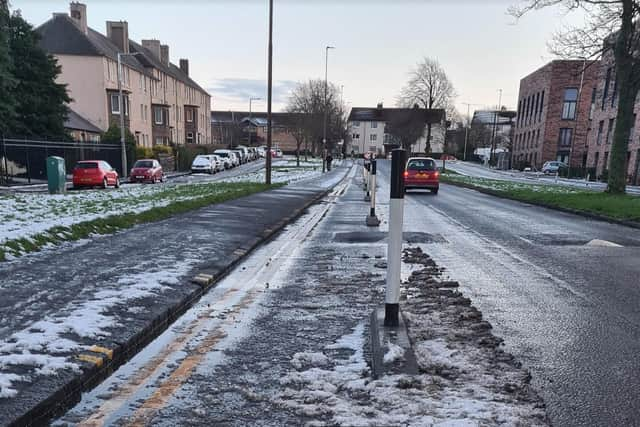Edinburgh cyclist needed surgery after crash with ‘dangerous’ base of temporary cycle lane bollard
and live on Freeview channel 276
Dean Loughton was riding in the cycle lane in Pennywell Road when he claims he veered right to avoid a pothole before his front wheel clipped the base of a black cycle lane defender, which he failed to see because of snow and poor visibility.
The 32-year-old, from Muirhouse, underwent surgery at the Royal Infirmary of Edinburgh on Monday and he says doctors have told him the healing process will take longer than usual because he has Type 1 diabetes.
Advertisement
Hide AdAdvertisement
Hide AdMr Loughton, who plans to start a petition to get the bollards removed, said: “They are meant to be there for the safety of the cyclist but these things are outrageously dangerous.
“If they were luminous yellow it would be better but they are black and it’s really hard to see them at night.”
Edinburgh City Council’s transport convener, Lesley Macinnes, wished Mr Loughton a speedy recovery but said the cycle lane defenders have reflective strips for night time visibility and are of industry standard.
Passing motorist Imran Hussain told the Edinburgh Evening News he was just inches from Mr Loughton when he crashed into the bollard at around 9:30pm last Tuesday.
Advertisement
Hide AdAdvertisement
Hide AdMr Hussain said it was fortunate he had moved his car over to the right of the road as he went over a speed bump, but believes if a bigger vehicle had been behind the cyclist it could have been much worse.


‘Hostile to bicycle wheels’
Professor Chris Oliver, of Lothian cycling campaign group Spokes, says the bollards concerned are not designed well for any road user.
He said: “The bases of the bollards are hostile to bicycle wheels if you collide with them at the wrong angle. The bollard bases should have a smooth confluent base with the roads surface to reduce the risk of throwing a cyclist off and causing a crash.
“Elbow fractures can be a nasty fractures and may lead to chronic long term disability with time off work. They often lead to costly litigation.


Advertisement
Hide AdAdvertisement
Hide Ad“As a car driver as well as a cyclist these bollards are also not visible enough and I’ve almost driven into one of the bollards myself whilst on Comiston Road.”
Dave Du Feu, also of Spokes, echoed the calls for improved design and visibility but said Mr Loughton’s unfortunate crash was the first one of its type the group has heard of. Spokes also highlight that, even if bollards are causing accidents, the protection they give against motor vehicles outweighs this.
Mr Du Feu said if the Spaces for People scheme were to be made permanent, the design would be different - more like the new segregated cycle lane at the east end of York Place - but acknowledged these permanent schemes are costly and take time to implement.
A report, set to go before the council’s transport committee on Thursday, asks councillors to approve a new public consultation and assessment criteria which officers and councillors will use to judge whether the temporary measures should be kept post-pandemic.
Advertisement
Hide AdAdvertisement
Hide AdOpponents of the scheme have reacted with dismay to the proposals, with one Tory councillor, Susan Webber, warning that making them permanent would risk “crippling the city” as it emerged from the pandemic.
Transport and environment convener, councillor Lesley Macinnes, said: “Since introducing our Spaces for People programme in May we’ve planned or delivered 39km of segregated cycle lanes across the city, providing safe, protected routes for people making essential journeys. Our ambitious approach has been welcomed by many people taking up cycling from the first time, families and more seasoned cyclists alike.
“Of course, our sympathies are with Mr Loughton and we wish him a speedy recovery. The type of cycle lane defenders we’re using, which include reflective strips for night time visibility, are industry standard for these kinds of interventions, and allow us to make such changes on a temporary basis. However, we’re always looking for feedback on these measures, and we’d encourage Mr Loughton to get in touch.”
The black cycle lane defenders were brought in to replace orange bollards as a more semi-permanent option for segregated cycle lanes in the latter part of 2020.
Advertisement
Hide AdAdvertisement
Hide AdEach project has carried out a full risk assessment and is subject to a Road Safety Audit upon completion.